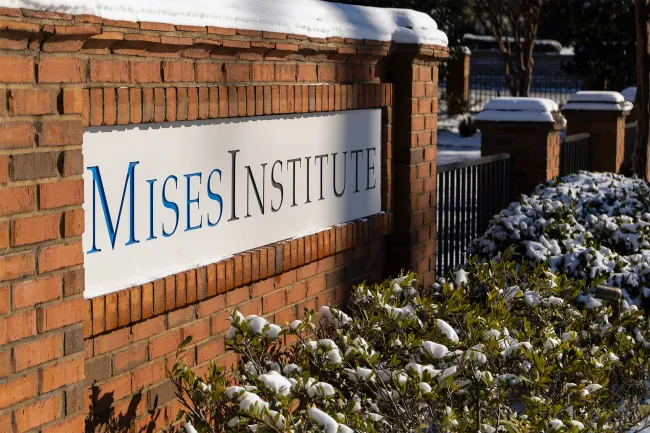In a previous article, I detailed how war—even during the American Revolution—contributed to centralization of power and statism, including higher taxes, price controls, and inflation. Doubtless it will be argued that these were necessary sacrifices to achieve independence from the British and that at least some degree of monetary inflation was necessary for American victory. In fact, this article will argue the opposite—monetary inflation threatened the cause of independence. Even though the colonies did achieve independence despite the consequences of inflation, it does not follow that inflation facilitated independence. A policy of inflation hindered, at least as much as it helped, the cause of independence, also contributing to great post-war economic instability.
In a letter to Jean Nicolas DéMeunier—commenting on his article concerning the US in DéMeunier’s Encyclopédie Méthodique—Thomas Jefferson wrote (June 22, 1786),
Every one thro[ugh] whose hands a bill passed, lost on that bill what it lost in value, during the time it was in his hands. This was a real tax on him; and in this way the people of the united states [sic] actually contributed…millions of dollars during the war, and by a mode of taxation the most oppressive of all, because the most unequal of all.
The hidden tax that funded the war, which Jefferson described as “the most oppressive of all,” was that of inflation via paper money. On June 22, 1775, Congress issued $2 million paper “bills of credit” (“Continentals”), but this would soon expand greatly. Rothbard explains the nature of this inflation,
Paper issues fraudulently pretend to be equivalent to units of specie and are used by the issuer to bid away resources in society from the producers and consumers, in the process depreciating the money itself. Its nature and consequences are equivalent to the process of counterfeiting.
Fiat paper monies were accepted because they were, at first, viewed as true money-substitutes and because there was a future promise of redemption: “...for everyone recognized that paper money would only circulate if some sort of redemption were pledged for the future.” This needs to be clarified before the MMT crowd gets too excited and misreads this as a case of chartalism. Keep in mind that multiple commodity monies already existed, independent of government intervention.
Rothbard described how this promised pseudo-redemption would work and how it further taxed the people: each colony would promise to redeem a pro rata share of the Continental paper issue beginning in 1779. The redemption would not be in specie, but taxes on the paper Continentals themselves, which would retire the money. In other words, through inflation, the Congress would expropriate purchasing power to itself and earlier recipients to pay for expenses, thus taxing the American people through depreciation of the money; then the people had the promise made that they would be taxed again at the end of the war to retire the inflated money instead of receiving specie.
Both the Confederation and the individual states “went heavily into the printing business.” By the time the original $2 million Continentals were ready, Congress had already decided it would not be enough and authorized another $1 million by the end of July. Before the end of 1775, a total of $6 million of inflated money was either printed or authorized. For context, the total money supply of the previous year was about $12 million, therefore, this issuance represented a 50 percent increase of the money supply in less than a year. G. Edward Griffin continues the story,
By the end of the [1775], another $3 million. In 1776, another $19 million. $13 million in 1777. $64 million in 1778. $125 million in 1779. And still more: the Continental Army issued its own “certificates” for the purchase of supplies totalling $200 million. A total of $425 million in five years on top of a base of $12 million is an increase of over 3500%. And, in addition to this massive expansion of the money supply on the part of the central government, it must be remembered that the states were doing exactly the same thing. It is estimated that, in just five years from 1775 to the end of 1779, the total money supply expanded by 5000%. By contrast, the amount raised in taxes over the five-year period was inconsequential, amounting to only a few million dollars. (emphasis added)
The effects of this monetary inflation by policy were predictable, yet staggering in their consequences. At first, of course, this felt like a “flush of apparent prosperity,” but rapid depreciation soon followed. After prices skyrocketed, and wage and price controls exacerbated the economic situation, a series of harsh legal tender laws soon followed in a desperate attempt to force people to give up their property and real production for increasingly worthless fiat paper.
Monetary Depreciation
In his History of the American Revolution (vol. 2, 1793), David Ramsay, writes, “While the credit of the money was well supported by public confidence and patriotism, its value diminished from the increase of its quantity. Repeated emissions begat that natural depreciation, which results from an excess of quantity.”
The rate and scope of depreciation is striking. While examining the depreciation, it is important to keep regional disparity in mind—the effects were neither evenly distributed nor uniform. That said, below is a rough ratio table showing the depreciation of a dollar Continental relative to a dollar in gold from 1775–1781:
1775: 1:1
January 1777: 1.05:1
January 1778: 3.25:1
January 1779: 7.45:1
March 1780: 40:1 (bill passed in March to declare the official new ratio of 40:1)
February 1781: 75:1
Mid-to-late 1781: 100 to 250:1
What began as a face-value currency in 1775 became, by 1781, a worthless fiat note—a 99.6 percent loss in value of six years. As the graph below demonstrates, utilizing multiple sources, the Continental dollar traded at face value (1:1) at first, but the value quickly plummeted relative to a gold dollar, reaching about 40:1 by 1780. The Philadelphia price index and Pennsylvania merchant account books track an even greater depreciation—approaching 150:1—by 1781. Post-1781 estimates from letters, newspapers, journals, etc. suggest extreme depreciation from 500:1 to 5,000:1.

The Costs of Inflation, Legal Tender Laws, Price Controls and the War Effort
Space does not permit the exploration of each of these topics in detail, however, a few quotes from some of the familiar main participants in the story of the American Revolution should suffice to show that inflation and other interventions—far from saving America from the British and ensuring American independence—almost cost independence, as well as causing several other acute problems.
In response to the depreciated paper, price controls, and legal tender laws, many simply stopped offering goods for sale. People did not want to exchange their property and production for increasingly-worthless paper at government-mandated price. Therefore, many withdrew their labor and/or goods from the market, further inflaming prices of goods remaining and shortages. The already-strained supply was lessened, the demand remained the same, and the money supply was artificially increased; consequently, the purchasing power of money decreased, non-controlled prices increased, and acute shortages were the result. In this context, George Washington remarked (April 23, 1779),
In the last place, though first in importance, I shall ask; is there any thing doing, or that can be done, to restore the credit of our money? The depreciation of it has got to so alarming a point, that a wagon-load of money will scarcely purchase a wagon-load of provisions. (emphasis added)
Earlier that year (January 15, 1779), Washington wrote to the committee of Congress concerning how depreciation came to be regarded,
But if the men were to be had, a question arises, whether they could be subsisted. The difficulty and expense would be excessive, and it is much to be doubted, whether our money, though aided by every exertion of government, would be able to bring out the resources of the country to answer so immense a demand…. The great impediment to all vigorous measures, is the state of our currency. What prospects there are of relieving it, what is to be expected from the measures taken to that effect, the committee to whom the subject is familiar, and by whom it is best understood, will judge. But I fear their operations will be too slow to answer the purposes of the next campaign; and, if the vast expenditures necessary to the plan under consideration were to be made, I should have little hope of the success of any project for raising the value of the currency that can be adopted. (emphasis added)
On December 6, 1777, John Adams wrote a letter to Elbridge Gerry about the unjust nature of inflation, namely, that it first allows the earlier buyer to purchase goods at a lower price—making later recipients purchase at higher prices; next, past contracts that originally specified payment in gold were paid in depreciating fiat paper, basically voiding the contract in reality while honoring in nominally. Adams wrote,
The rapid translation of property from hand to hand, the robbing of Peter to pay Paul, alarms and distresses me beyond measure. The man who lent another a hundred pounds in gold four years ago, and is paid now in paper, cannot purchase with it one quarter part in pork, beef, or land, of what he could when he lent the gold. This is fact, and facts are stubborn things in opposition to speculation. (emphasis added)
While creditors being chased by debtors with paper money may not elicit much sympathy among some, we should consider that monetary inflation and contraventions of property rights harm everyone, especially the poor. Josiah Quincy wrote a letter to Washington (November 27, 1780) that details some of the monetary interventions and their effects, including on the defense of the united States,
Our new paper money, issued by recommendation of congress, no sooner began to circulate, than two dollars of it were given for one hard one. To restore the credit of paper, by making it a lawful tender, by regulating acts, or by taxes, are political manoeuvres that have already proved abortive, and for this obvious reason,—that, in the same proportion as ideal money is forced into currency, it must, from the nature of every thing fraudulent, be forced out of credit…I am firmly of the opinion, and think it entirely defensible, that there never was a paper pound, a paper dollar, or a paper promise of any kind, that ever yet obtained a general currency, but by force or fraud, generally by both. That the army has been grossly cheated; that creditors have been infamously defrauded; that the widow and fatherless have been oppressively wronged and beggared; that the gray hairs of the aged and the innocent, for want of their just dues, have gone down with sorrow to their graves, in consequence of our disgraceful depreciated paper currency,—may now be affirmed, without hazard of refutation; and, I wish it could be said, with truth, that the war has not thereby been protracted. May it not, therefore, be safely concluded that no kind of paper currency is adequate to the purpose of collecting and combining the forces of the United States for their common defence? (emphasis added)
These are examples to which many more could be added. Suffice it to say that the policy of inflation to fund the American Revolution was one of the most costly methods of taxation and even threatened the success of the independence movement, not to mention its post-Revolution consequences. While the American Revolution is often considered a libertarian revolution, it is clear that a state-centric model—government inflation, standing armies, etc.—not only threatened the cause, but virtually ensured post-war centralization of government powers. War, even the American Revolution, is the health of the state because it is almost impossible to avoid fighting a war on state-centric terms.


